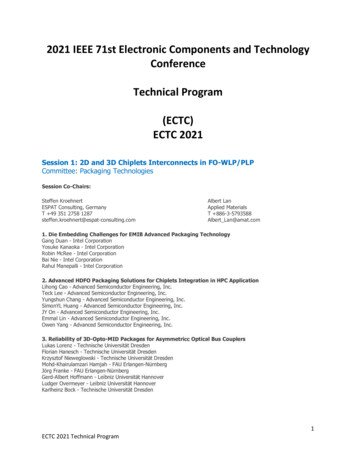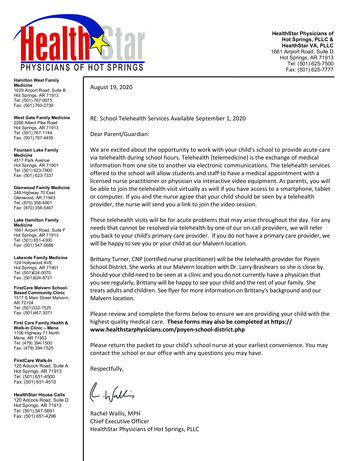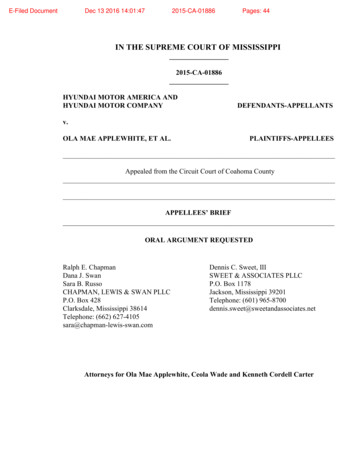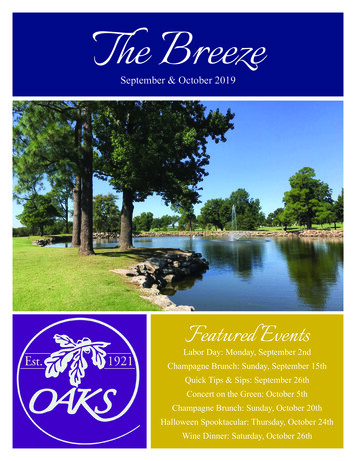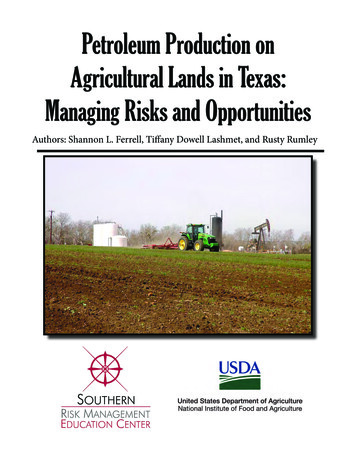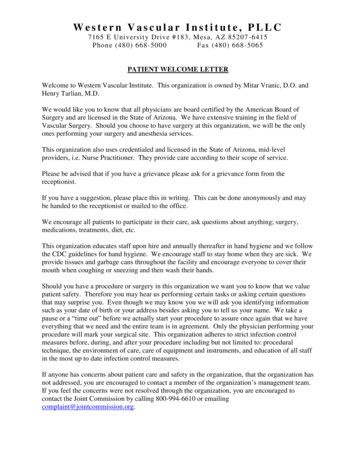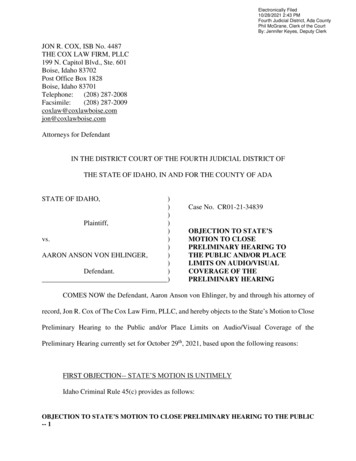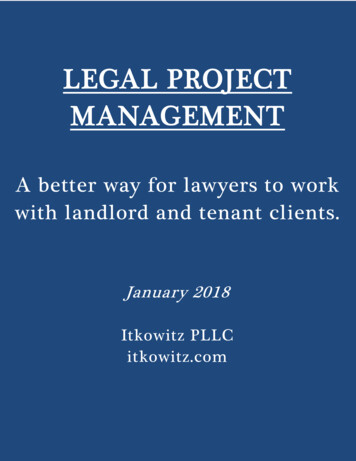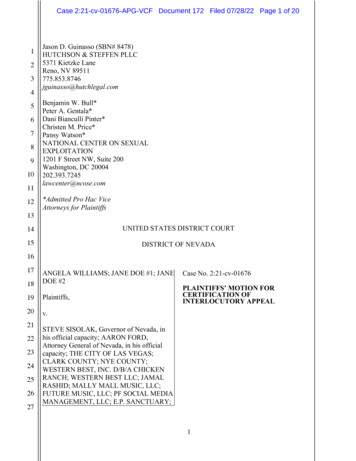
Transcription
Case 2:21-cv-01676-APG-VCF Document 172 Filed 07/28/22 Page 1 of 20123456789101112Jason D. Guinasso (SBN# 8478)HUTCHSON & STEFFEN PLLC5371 Kietzke LaneReno, NV 89511775.853.8746jguinasso@hutchlegal.comBenjamin W. Bull*Peter A. Gentala*Dani Bianculli Pinter*Christen M. Price*Pansy Watson*NATIONAL CENTER ON SEXUALEXPLOITATION1201 F Street NW, Suite 200Washington, DC 20004202.393.7245lawcenter@ncose.com*Admitted Pro Hac ViceAttorneys for Plaintiffs1314UNITED STATES DISTRICT COURT15DISTRICT OF NEVADA161718ANGELA WILLIAMS; JANE DOE #1; JANEDOE #219Plaintiffs,20v.21STEVE SISOLAK, Governor of Nevada, inhis official capacity; AARON FORD,Attorney General of Nevada, in his officialcapacity; THE CITY OF LAS VEGAS;CLARK COUNTY; NYE COUNTY;WESTERN BEST, INC. D/B/A CHICKENRANCH; WESTERN BEST LLC; JAMALRASHID; MALLY MALL MUSIC, LLC;FUTURE MUSIC, LLC; PF SOCIAL MEDIAMANAGEMENT, LLC; E.P. SANCTUARY;222324252627Case No. 2:21-cv-01676PLAINTIFFS’ MOTION FORCERTIFICATION OFINTERLOCUTORY APPEAL1
Case 2:21-cv-01676-APG-VCF Document 172 Filed 07/28/22 Page 2 of 206BLU MAGIC MUSIC, LLC; EXCLUSIVEBEAUTY LOUNGE, LLC; FIRSTINVESTMENT PROPERTY LLC; V.I.P.ENTERTAINMENT, LLC, MP3PRODUCTIONS, INC., & MMMPRODUCTIONS, INC.; SHAC, LLC D/B/ASAPPHIRE GENTLEMAN’S CLUBAND/OR SAPPHIRE; SHAC MT, LLC; andLAS VEGAS BISTRO, LLC D/B/A LARRYFLYNT’S HUSTLER CLUB;7Defendants.1234589Plaintiffs Angela Williams, Jane Doe #1, and Jane Doe #2 by and through their counsel10of record, hereby file this Motion for Certification of Interlocutory Appeal. The following11Memorandum of Points and Authorities explains the reason for this Motion.STATEMENT OF RELIEF SOUGHT AND ISSUES TO BE DECIDED12Plaintiffs request that the Court certify the Order on Motions to Dismiss, Strike, and1314Intervene, ECF 171, for interlocutory appeal under 28 U.S.C. § 1292(b).MEMORANDUM OF POINTS AND AUTHORITIES15I.16INTRODUCTION17Slavery in this country has always been deeply intertwined with prostitution and sex18trafficking, and has especially flourished where it has enjoyed official protection. See Pls. First19Am. Compl. ECF 49 at ¶¶ 48-75. Plaintiffs’ lawsuit alleges that Governor Sisolak and Attorney20General Ford (State Defendants); and the City of Las Vegas, Clark County, and Nye County (City21Defendants) (collectively, Government Defendants) have colluded with private entities –22including defendants who run escort businesses, strip clubs, and a brothel – to facilitate and profit23from sex trafficking in violation of the Thirteenth Amendment and the Trafficking Victims24Protection Act (TVPRA). ECF 49 at ¶ 9. On July 18, 2022, this Court issued a ruling resolving25the various pending motions to strike, dismiss, and intervene.126127On November 16, Defendant Clark County filed its Motion to Strike, ECF 53, which wasjoined by the State Defendants, ECF 58; the City of Las Vegas, ECF 69; Nye County, ECF 71;2
Case 2:21-cv-01676-APG-VCF Document 172 Filed 07/28/22 Page 3 of 201The Court granted the motions to dismiss as to these Government Defendants on standing2grounds, ruling that Plaintiffs’ injuries were affected by third parties and too far removed from3the government actors’ conduct. ECF 171 at 6-9. Plaintiffs seek permission to appeal the4causation ruling. Plaintiffs argue that whether standing may be interpreted to nullify a federal5cause of action is a controlling question of law, that substantial grounds for differences of opinion6exist because it is novel and can be reasonably interpreted in different ways, and that deciding the7question now on appeal will save time and resources later. Accordingly, certification for8interlocutory appeal is merited here.9II.BACKGROUNDA. Plaintiffs’ allegations against Government Defendants as to causation1011Plaintiffs’ Amended Complaint alleged that sex trafficking increases in hospitable legal12environments – that is, those that legalize or otherwise tolerate prostitution, and that State and13City Defendants have colluded with Sex Industry Defendants to produce just such an14environment, not least by licensing sex trade businesses, and by failing to enforce federal laws15against debt bondage and sex trafficking. See, e.g., ECF 49 at ¶¶ 94, 96, 100-104, 108-126,147.16Plaintiffs have alleged that consequently, they were exploited for commercial sex in Nevada17through force, fraud, and coercion – including psychological manipulation and debt bondage –18in legal strip clubs, legal escort businesses, and a legal brothel. See, e.g., ECF 49 at ¶ 149.19Plaintiffs have alleged specific facts implicating Government Defendants in Plaintiffs’ sex20trafficking.See, e.g., ECF 49 at ¶¶ 94-100, 131 (detailing how State Defendants permit21prostitution in rural counties, force STI testing on prostituted people but not sex buyers, do not22enforce their own regulations limiting prostitution advertising, and permit escorting and23“entertainment by referral service” throughout Nevada); ECF 49 at ¶¶ 101-104 (detailing how242526and the Brothel Defendants, ECF 99. The Brothel Defendants filed a Motion to Dismiss, ECF98; as did Sapphire, ECF 133; and the State Defendants, ECF 168. The Escort AgencyDefendants failed to respond and are in default. ECF 150-159.273
Case 2:21-cv-01676-APG-VCF Document 172 Filed 07/28/22 Page 4 of 201State Defendants allow counties to self-regulate and do not bar brothel debt bondage practices);2ECF 49 at ¶¶ 108-114 (detailing how Nye County not only permits brothel prostitution but does3not ban compelled prostitution, as long as it occurs in a brothel, prevents persons in prostitution4from operating independently, and has discretion about licensing felons to operate brothels); ECF549 at ¶¶ 115-119, 125 (detailing how Las Vegas permits escorting and strip clubs, and forces6escorts to work for an escort agency and to undergo STI testing for licensure); ECF 49 at ¶¶ 115,7120-125 (detailing how Clark County permits escorting, outcall entertainment, and strip clubs).8Plaintiffs also alleged that the legal climate Government Defendants have created led to9high demand for sex buying, ECF 49 at ¶¶ 127-131, and a disproportionately large sex trade, ECF1049 at ¶ 141, yet Defendants have a sparse record of sex trafficking prosecutions, ECF 49 at ¶¶11134, 142, and even outright corruption in their law enforcement, ECF 49 at ¶¶ 137-138, 182-184.12And Plaintiffs alleged that this prostitution system is profitable for Government Defendants, due13to the tourism it motivates, as well as the taxes and licensing fees that brothels, escort agencies,14and strip clubs generate. ECF 49 at ¶¶ 136, 142-144.B. Government Defendants’ arguments on causation1516Government Defendants claimed that Plaintiffs failed to sufficiently allege standing,17arguing that traceability to Clark County and Jane Doe #2’s sex trafficking was attenuated due to18third party bad actors. ECF 53 at 18. Nye County’s sole argument against causation was the bare19assertion that Plaintiffs’ allegation that legalized prostitution increases demand was “far too20attenuated to link . . . Plaintiffs’ alleged injuries to Nye County for the purposes of establishing21standing.” ECF 71 at 4. The State and the City offered no specific arguments against Plaintiffs’22allegations about their causal role in Plaintiffs’ sex trafficking. See ECF 53 at 18, ECF 58, ECF23168.24In response, Plaintiffs referenced the facts described above and argued that Nevada25officials are sex trafficking enablers and profiteers, and that their injuries were traceable at least26in part to Government Defendants’ conduct. See ECF 82 at ¶¶ 8-14, 16-17.274
Case 2:21-cv-01676-APG-VCF Document 172 Filed 07/28/22 Page 5 of 20C. This Court’s ruling on standing12Largely due to the various traffickers and groomers who exploited Plaintiffs, this Court3found that too many third parties’ “independent decisions collectively had a significant effect on4the plaintiffs’ injuries.” ECF 171 at 7 (cleaned up). The Court thus ruled that Plaintiffs’5allegations that Nevada’s legal prostitution system leads to an increased illegal sex trade2 were6insufficient to “plausibly allege that the injuries they suffered are fairly traceable” to Government7Defendants and granted their motions to dismiss on standing grounds. ECF 171 at 7-8.8The Court also denied Sapphire and the Brothel Defendants’ motions to dismiss the direct9and beneficiary sex trafficking claims, finding that Plaintiffs had stated claims for TVPRA10violations. ECF 171 at 12-16. The Order granted the motions to dismiss otherwise, including11all the claims against the Government Defendants, and the Thirteenth Amendment claims against12Sapphire and the Brothel Defendants. ECF 171 at 18-19. The Court also denied the motion to13intervene from a sex buyer. ECF 171 at 19.Plaintiffs seek certification for interlocutory appeal as to the Court’s dismissal of their claims1415against the Government Defendants on standing grounds.III.16ARGUMENT17“A non-final order may be certified for interlocutory appeal where it involves a controlling18question of law as to which there is substantial ground for difference of opinion and where an19immediate20the litigation.” Reese v. BP Expl. (Alaska) Inc., 643 F.3d 681, 687–88 (9th Cir. 2011) (internal21quotation marks omitted) (quoting 28 U.S.C. § 1292(b)).appealfromtheordermay materially advance theultimate termination of22Plaintiffs will argue that A) whether Plaintiffs have Article III standing to bring Thirteenth23Amendment and sex trafficking claims against Government Defendants is a controlling question24of law; B) substantial grounds for difference of opinion exist as to whether a court may interpret25standing’s causation prong to exclude rights violators that the TVPRA explicitly intends to cover;26227The Court’s Order did not analyze or even address Plaintiffs’ numerous other allegationsimplicating the Government Defendants, which are summarized above. See ECF 171 at 6-8.5
Case 2:21-cv-01676-APG-VCF Document 172 Filed 07/28/22 Page 6 of 201and C) because a final appeal could lead to duplication and delay, interlocutory appeal may2materially advance the ultimate termination of this litigation.34A. Whether Plaintiffs have Article III standing to bring ThirteenthAmendment and sex trafficking claims against Government Defendants isa controlling question of law56To be certified for interlocutory appeal, an order must “involve[] a controlling question of7law[.]” 28 U.S.C. § 1292(b). A controlling question of law is one that would materially affect8case’s outcome. In re Cement Antitrust Litig., 673 F.2d 1020, 1026 (9th Cir. 1981). The question9need not determine who will prevail on merits to be controlling. Kuehner v. Dickinson & Co., 8410F.3d 316, 319 (9th Cir. 1996), as amended (July 5, 1996).11Standing is a question of law. See, e.g., Salmon Spawning & Recovery All. v. Gutierrez,12545 F.3d 1220, 1224 (9th Cir. 2008) (standing is a question of law where the complaint was13dismissed on causation and redressability grounds); Bernhardt v. Cnty. of Los Angeles, 279 F.3d14862, 867 (9th Cir. 2002) (“Standing is a question of law reviewed de novo.”); Columbia Basin15Apartment Ass’n v. City of Pasco, 268 F.3d 791, 796–97 (9th Cir. 2001) (same); Missouri on16Mainland, Inc. v. Dalton, 230 F.3d 1367 (9th Cir. 2000) (same).17The Ninth Circuit has treated standing as a question of law, even when it considered18plaintiffs’ factual allegations as to standing under the motion to dismiss standard. See also Jewel19v. Nat’l Sec. Agency, 673 F.3d 902, 907 (9th Cir. 2011) (considering standing to be a question of20law while recognizing the factual inquiry involved, and noting that plaintiffs’ factual allegations21must be taken as true when analyzing a motion to dismiss for lack of standing).22Additionally, standing determinations can be considered controlling questions of law in23the interlocutory appeal certification context. See, e.g., Asis Internet Servs. v. Active Response24Grp., No. C07 6211 TEH, 2008 WL 4279695, at *2–3 (N.D. Cal. Sept. 16, 2008) (cleaned up)25(“The standing issue in this case is a controlling question of law. A question of law is controlling26if resolution of the issue on appeal could materially affect the outcome of litigation in the district276
Case 2:21-cv-01676-APG-VCF Document 172 Filed 07/28/22 Page 7 of 201court.”); Omni MedSci, Inc. v. Apple Inc., No. 19-CV-05924-YGR, 2020 WL 759514, at *1 (N.D.2Cal. Feb. 14, 2020) (cleaned up) (“Standing and subject-matter jurisdiction are controlling issues3of law.”); In re Outlaw Lab’ys, LP Litig., No. 18-CV-840-GPC, 2022 WL 1445375, at *2 (S.D.4Cal. May 6, 2022) (“Because the question of standing goes to the fundamental question of5jurisdiction, the Court concludes that there is a controlling question of law to be addressed, as6required by 28 U.S.C. § 1292(b).”).7Here, Plaintiffs seek certification of the Court’s decision, based on standing, to dismiss8the government defendants, ECF 171 at 6-8, and standing is a controlling question of law in the9Ninth Circuit, as detailed above. The standing determination also has a material effect on the10case’s outcome: all the Government Defendants have been dismissed from the lawsuit. ECF 17111at 18.12Defendants due to their role in the systemic nature of sex trafficking in Nevada. See, e.g., ECF1349 at ¶¶ 94-100, 131; ECF 49 at ¶¶ 101-104; ECF 49 at ¶¶ 108-114; ECF 49 at ¶¶ 115-119, 125;14ECF 49 at ¶¶ 115, 120-125. The Article III standing question determines whether the case can15address government conduct at all, and accordingly whether the case’s outcome will include relief16as to official complicity and profiteering in sex trafficking.Plaintiffs have alleged constitutional and statutory violations against Government17Defendants may argue that the standing question is fact-specific, not a pure question of18law. As noted above, this Circuit considers standing to be a question of law. Moreover, Plaintiffs’19facts cannot be disputed at the motion to dismiss stage. See Ashcroft v. Iqbal, 556 U.S. 662, 67820(2009).3 But even assuming, arguendo, that the standing analysis involves mixed questions of212223242526273To establish Article III standing, plaintiffs must demonstrate they have “(1) suffered an injuryin fact, (2) that is fairly traceable to the challenged conduct of the defendant, and (3) that is likelyto be redressed by a favorable judicial decision.” Spokeo, Inc. v. Robins, 578 U.S. 330, 338(2016), as revised (May 24, 2016) (cleaned up). At the motion to dismiss stage, “general factualallegations of injury resulting from the defendant’s conduct may suffice, for on a motion todismiss we presume that general allegations embrace those specific facts that are necessary tosupport the claim.” Lujan v. Defs. of Wildlife, 504 U.S. 555, 561(1992) (cleaned up). That is,Plaintiffs need not prove standing, but they must sufficiently allege it.7
Case 2:21-cv-01676-APG-VCF Document 172 Filed 07/28/22 Page 8 of 201law and fact,4 if an identifiable question of “pure law” exists, the court may consider all issues2material to that question. Steering Comm. v. United States, 6 F.3d 572, 575–76 (9th Cir. 1993).3At least one question of pure law is presented here, as will be detailed below: whether a court4may interpret the standing requirement’s causation prong to exclude a class of rights violators5that federal law explicitly intends to cover.6Because whether Plaintiffs have Article III standing to sue Government Defendants7determines whether the case even proceeds against government actors, a controlling question of8law is present.B. Substantial grounds for difference of opinion exist as to whether a courtmay interpret standing’s causation prong to exclude rights violators thatthe TVPRA explicitly intends to cover.910To merit interlocutory appeal, there must be “substantial ground for difference of opinion”1112on the controlling question of law. 28 U.S.C. § 1292b.“Substantial ground for difference of opinion” can exist where an issue “raise[s] novel1314and difficult questions of first impression.” Roberts v. AT&T Mobility LLC, 877 F.3d 833, 83715(9th Cir. 2017) (cleaned up). If the controlling legal issue is novel, petitioners need not wait for16conflicting or varied authority. As the court in Reese noted:[C]ourts traditionally will find that a substantial ground for difference of opinionexists where novel and difficult questions of first impression are presented, as isthe case here. Our interlocutory appellate jurisdiction does not turn on a priorcourt’s having reached a conclusion adverse to that from which appellants seekrelief. A substantial ground for difference of opinion exists where reasonable juristsmight disagree on an issue's resolution, not merely where they have alreadydisagreed. Stated another way, when novel legal issues are presented, on whichfair-minded jurists might reach contradictory conclusions, a novel issue may becertified for interlocutory appeal without first awaiting development ofcontradictory precedent.1718192021222324Reese v. BP Expl. (Alaska) Inc., 643 F.3d 681, 688 (9th Cir. 2011) (cleaned up).2542627And if it is truly a mixed question of law and fact, the Order should be amended to permitPlaintiffs to amend their Complaint to allege additional facts about Government Defendants’role in sex trafficking, rather than dismissing the claims with prejudice.8
Case 2:21-cv-01676-APG-VCF Document 172 Filed 07/28/22 Page 9 of 201Whether a court may interpret standing’s causation prong to exclude a class of rights2violators that the TVPRA explicitly intends to cover is a novel question of first impression. The3Court ruled that because “independent decisions” of “numerous third parties” had “collectively .4. . . a significant impact the plaintiffs’ injuries,” Plaintiffs failed to allege harms “fairly traceable”5to Government Defendants. ECF 171 at 7 (cleaned up). No case has ever directly addressed6whether the causation factor in the Article III standing analysis can be interpreted to exclude sex7trafficking beneficiaries, in particular when the causation chain is complex due to the rights8violation’s systemic nature.9This is also a question where judges may reasonably disagree with how the Order resolves10the causation question, because by implication it would exclude sex trafficking beneficiary11claims, and it is inconsistent with other relevant rulings.12First, the Court’s ruling, taken to its logical end, would prevent lawsuits against13government beneficiaries of sex trafficking, even though federal laws against sex trafficking14expressly provide for beneficiary liability. See 18 U.S.C. § 1595(a). Section 1595(a) allows sex15trafficking victims to sue anyone who “knowingly benefits, financially or by receiving anything16of value” from participating in what the person knew or should have known was sex trafficking.1718 U.S.C. § 1595(a). The provision’s entire premise is that an entity can be liable for standing by18and profiting, even if the entity was not directly causing the injury. See, e.g., 18 U.S.C. § 1595(a);19M.A. v. Wyndham Hotels & Resorts, Inc., 425 F. Supp. 3d 959, 974 (S.D. Ohio 2019) (recognizing20that Congress defined sex trafficking violations to include roles that more passive actors play in21enabling and profiting from abuse).52223242526275The Thirteenth Amendment is also meaningless if the government cannot be held accountablefor incentivizing or protecting private actors’ bad conduct. Government defendants can beimplicated even where third -party conduct is a precondition for a completed ThirteenthAmendment violation. See Bailey v. Alabama, 219 U.S. 219, 227–28 (1911). This is particularlytrue given that the Thirteenth Amendment’s context was that independent, private actors were aconstant threat to the newly freed people, and states could be held responsible for not controllingthem. See, e.g., Katyal, Men Who Own Women, 103 YALE L.J. 791, 820–22 n.171- 175 (1993)(internal citations omitted).9
Case 2:21-cv-01676-APG-VCF Document 172 Filed 07/28/22 Page 10 of 201As the hundreds if not thousands of rapes perpetrated by sex buyers are the primary source2of the sexual assault and other violence in prostitution, see ECF 49 at ¶¶ 85, 127, 160-164, 195-396, 214, 223, 243, 306-307, numerous third parties’ independent decisions (to buy sex) are always4present in the sex trafficking context. A causation standard requiring no third parties to have5significantly intervened to cause any of the harm would mean that that beneficiaries cannot6actually be held liable under the TVPRA, because victims would have no standing to sue them.7To follow the Court’s logic to its end would thus make benefitting from sex trafficking almost8non-actionable. Given that this approach to causation undermines a federally enacted cause of9action, reasonable jurists can differ on whether the approach is correct.1011Second, the Court’s approach to causation is inconsistent with other relevant rulings(including its own), both in the TVPRA context and otherwise.12TVPRA cases presume standing can be found where independent third parties cause injury.13See, e.g., M.A., 425 F. Supp. 3d at 974 (finding plaintiff stated a claim against hotel franchisors for14sex trafficking beneficiary liability where franchisors knowingly profited from what they should15have known was sex trafficking); S.Y. v. Wyndham Hotels & Resorts, Inc. & Laxmi of Naples,16LLC, No. 2:20-CV-619-JES-MRM, 2021 WL 1814651, at *4-5 (M.D. Fla. May 6, 2021); E.S. v.17Best W. Int’l, Inc., No. 3:20-CV-00050-M, 2021 WL 37457, at *3–4 (N.D. Tex. Jan. 4, 2021); S.J.18v. Choice Hotels Int’l, Inc., 473 F.Supp.3d 147, 152-54 (E.D.N.Y. 2020); Doe S.W. v. Lorain-19Elyria Motel, Inc., Case No. 2:19-cv-1194, 2020 WL 1244192, *6-7 (S.D. Ohio Mar. 16, 2020).20Hotels have been liable despite the central role third parties play in the harm. See M.A.,21425 F. Supp. 3d at 974. And Government Defendants hold more power over traffickers in their22jurisdictions than hotels do over traffickers on their property; as Plaintiffs have alleged,23Government Defendants have the authority to license, tax, regulate, investigate, and prosecute24prostitution businesses. See ECF 49 at ¶¶ 22-27, 96, 100, 116-126, 139-140.25And this Court itself found that Plaintiffs stated a cause of action against Sapphire and26Brothel Defendants for sex trafficking. ECF 171 at 12-16. The Court did not question whether2710
Case 2:21-cv-01676-APG-VCF Document 172 Filed 07/28/22 Page 11 of 201Plaintiffs had standing against Sapphire and the Brothel Defendants, even though numerous third2parties (sex buyers) intervened and contributed to their injuries. See ECF 49 at ¶¶ 243, 245-249,3270, 274-76, 279, 306-307.4Plaintiffs alleged that Sapphire and the Brothel Defendants pay taxes and fees to the5government to engage in these activities, not to mention the tourism revenues Government6Defendants receive due to Nevada’s status as a sex trade haven. ECF 49 at ¶¶ 135-136, 143-144,7339-342.8prostitution, including when it amounts to sex trafficking. As this Court held that Plaintiffs stated9a cause of action against Sapphire and Brothel Defendants for direct liability, and Plaintiffs have10alleged that Government Defendants benefited financially from their activities, Plaintiffs11necessarily have stated a cause of action against Government Defendants for beneficiary liability12under federal law, see 18 US.C. § 1591(a)(2); 18 U.S.C. § 1595(a), yet the Order maintains13Plaintiffs have no standing to sue.Plaintiffs thus alleged that the Government Defendants benefit financially from14The TVPRA case law is consistent with how other cases in this Circuit have analyzed15standing where numerous third party actors’ conduct is also at issue. For example, Defendants’16conduct need not be sole cause of Plaintiffs’ injury to satisfy standing. Barnum Timber Co. v.17U.S. E.P.A., 633 F.3d 894, 901 (9th Cir. 2011) (“Barnum has alleged that at least EPA’s listing18of Redwood Creek has affected the value of its property. It need not eliminate any other19contributing causes to establish its standing.”).20Additionally, Defendants’ conduct need not be the last act in the causation chain either.21In Ning, the Defendant contested Plaintiff’s Article III standing on causation grounds. Ning22Xianhua v. Oath Holdings, Inc., 536 F. Supp. 3d 535, 549–51 (N.D. Cal. 2021). The Court said23that the “Supreme Court has stated that Article III standing does not require that the defendant's24actions be the last step in the chain of causation.” Id. (noting that third parties can act injuriously25after the defendant’s alleged misconduct without destroying standing).262711
Case 2:21-cv-01676-APG-VCF Document 172 Filed 07/28/22 Page 12 of 201The Plaintiff in Ning had sufficiently alleged causation where Chinese authorities tortured2and imprisoned him based on his “pro-democracy communications” through his Yahoo email3account. Id. The Plaintiff alleged that the state could not have known about his activities unless4Yahoo shared the account information with them. Id. at 550–51 (internal citations omitted)The court in Ning noted several other examples where causation was met even though56third parties’ actions contributed to or arguably even directed the harm: 7Plaintiffs in an Anthem-administered health plan alleged causation where Anthem had adata breach and hackers used the Plaintiffs information.8 9Plaintiffs, who were terrorism victims, also alleged causation against Chevron for10enabling Saddam Hussein to make reward payments to terrorists’ families to incite11attacks.6 “Although the plaintiffs alleged that, following Chevron's alleged misconduct,12there were two other steps in the causal chain (Hussein's payment to the terrorists and the13terrorists’ perpetration of the attacks), the court nevertheless concluded that the plaintiffs’14injury was fairly traceable to Chevron's alleged misconduct.”15Id. at 549–51 (internal citations omitted).16These cases indicate that the chain of causation can be long and involve third parties’17independent actions, just not attenuated or hypothetical. So too here: Plaintiffs have alleged that18in the highly lucrative prostitution industrial complex in Nevada, public and private entities19reinforce and benefit each other. ECF 49 at ¶¶ 94-147, 182-184. Sex traffickers do not act in20isolation, especially not on the scale of Nevada’s sex trade; they have enablers, facilitators,21customers, and profiteers. See ECF 49 at id.7 Essentially, Plaintiffs have alleged that the22causation chain in Nevada’s prostitution system is a web: it is not attenuated or hypothetical just23242526276Chevron paid millions in illegal kickbacks for access to Iraqi oil, which ultimately ended up ina fund from which Hussein paid the terrorists. See Brill v. Chevron Corp., No. 15-CV-04916JD, 2017 WL 76894, at *1 (N.D. Cal. Jan. 9, 2017)7Plaintiffs also alleged facts detailing the history of how similar systems worked in other slaverycontexts. See ECF 49 at ¶¶ 48-75.12
Case 2:21-cv-01676-APG-VCF Document 172 Filed 07/28/22 Page 13 of 201because it is complex, broad, and multifactored; that’s just what it looks like when everyone is in2on the racket.3Thus, this case presents a novel question of first impression where reasonable judges4might disagree: whether causation in a standing analysis may be interpreted to exclude rights5violators that the TVPRA explicitly intends to cover.67C. Because a final appeal could lead to duplication and delay, interlocutoryappeal may materially advance the ultimate termination of this litigation8The final prong of the interlocutory appeal standard is that the proposed interlocutory9appeal “may materially advance the ultimate termination of the litigation[.]” 28 U.S. Code §101292. See also In re Cement Antitrust Litig., 673 F.2d at 1026.11The material advancement requirement does not mean that the appeal outcome must have12the potential to end the litigation altogether. See Reese, 643 F.3d at 688 (cleaned up) (finding13interlocutory certification appropriate) (“Neither § 1292(b)'s literal text nor controlling precedent14requires that the interlocutory appeal have a final, dispositive effect on the litigation, only that it15may materially advance the litigation.”).16Avoiding the delays, costs, or other inefficiencies of a later appeal, such as duplicative17discovery, suffices to meet this factor. See, e.g., Cooper v. Tokyo Elec. Power Co., Inc., 166 F.18Supp. 3d 1103, 1143 (S.D. Cal. 2015), aff’d, 860 F.3d 1193 (9th Cir. 2017) (finding that19“resolution of this issue would materially advance the ultimate termination of this litigation”20because if the defendant later “successfully appealed this Court's determination regarding the lack21of subject matter jurisdiction” the parties would have wasted time and money.); Jaco v. WinCo22Holdings, Inc., No. 118CV00301DADEPG, 2019 WL 2615739, at *5 (E.D. Cal. June 26, 2019)23(internal citations omitted) (“Despite not posing the potential of immediately terminating this24action, an interlocutory appeal may materially advance the litigation because it would prevent a25duplicative discovery process if this court's prior order were to be vacated.”); Rollins v. Dignity26Health, No. 13-CV-01450-TEH, 2014 WL 6693891, at *4 (N.D. Cal. Nov. 26, 2014) (“By2713
Case 2:21-cv-01676-APG-VCF Document 172 Filed 07/28/22 Page 14 of 201addressing this question now, the Court saves time and expense. If the Ninth Circuit reverses, the2parties can turn to these issues sooner rather than later. And if the Court of Appeals affirms, the3case can proceed on the relatively few issues that remain with greater certainty.”).4Because the Order dismissed with prejudice, ECF 171 at 8, it is not possible for Plaintiffs5to simply amend the Complaint. Plaintiffs could litigate against the Sex Industry Defendants6now, and wait to appeal this Court’s ruling on standing dismissing the government entities until7after the Court issues a
SAPPHIRE GENTLEMAN'S CLUB AND/OR SAPPHIRE; SHAC MT, LLC; and LAS VEGAS BISTRO, LLC D/B/A LARRY FLYNT'S HUSTLER CLUB; Defendants. Plaintiffs Angela Williams, Jane Doe #1, and Jane Doe #2 by and through their counsel of record, hereby file this Motion for Certification of Interlocutory Appeal. The following

